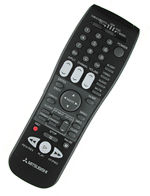Mitsubishi WT-46807 46-Inch HD-Ready Television Page 2
 There are a total of five aspect-ratio options. The first four are pretty standard. "Narrow" displays most regular TV, videotapes, and satellite broadcasts (1.33-shaped images) with correct geometry and blank space on the left and right sides of the screen. The "stretched" mode (available only for NTSC, or 480i, sources) takes the same source material and stretches it, less in the center and more so at the edges, to fill the screen. The "expand" setting stretches the picture evenly and equally in both horizontal and vertical directions, making movies that have been letterboxed for 1.33 displays (like laserdiscs and some DVDs) fill the screen with little or no blank space. "Standard" mode is made to fit anamorphic DVDs. Play your anamorphic or "enhanced for widescreen" DVDs in this mode for the best picture quality. Don't forget to set your DVD player to the 16:9 output. An added bonus is the "zoom" mode. This is similar to the expand mode, except that it zooms in on anamorphic material, not 1.33 images—again pushing potential letterboxed bars off the screen.
There are a total of five aspect-ratio options. The first four are pretty standard. "Narrow" displays most regular TV, videotapes, and satellite broadcasts (1.33-shaped images) with correct geometry and blank space on the left and right sides of the screen. The "stretched" mode (available only for NTSC, or 480i, sources) takes the same source material and stretches it, less in the center and more so at the edges, to fill the screen. The "expand" setting stretches the picture evenly and equally in both horizontal and vertical directions, making movies that have been letterboxed for 1.33 displays (like laserdiscs and some DVDs) fill the screen with little or no blank space. "Standard" mode is made to fit anamorphic DVDs. Play your anamorphic or "enhanced for widescreen" DVDs in this mode for the best picture quality. Don't forget to set your DVD player to the 16:9 output. An added bonus is the "zoom" mode. This is similar to the expand mode, except that it zooms in on anamorphic material, not 1.33 images—again pushing potential letterboxed bars off the screen.
Mitsubishi continues to excel with their ergonomic interface. The remote control is easy to understand, fits in your hand, and is laid out well—you can reach most buttons with just a couple of fingers. It would be nice if more of the remote was lit, particularly the labels. You can, though, control other devices if you take the time to program the unit. The remote's adjustment arrows also guide you through the colorful and aesthetically pleasing onscreen menu. Mitsubishi does a better job than most in making a user-friendly interface.
Finding and making adjustments with the onscreen menu is both simple and functional. You can make separate picture adjustments (contrast, brightness, color, tint, sharpness, and color temperature) for each input, which gives you the ability to dial-in the picture for every source. These adjustments can actually be set correctly for most images. The reasonably accurate color decoder, for example, allows the color and tint controls to be maximized, which in turn provides a rich and vibrant picture. Average fleshtones are a hair pink, but it's nothing that a slight adjustment doesn't correct. Combine the color level with a fairly accurate color-temperature setting, and the result is a natural color palette.
Black levels are also fairly good. Tests and demos show that the set keeps shadow details pretty consistent, although blacks do get a bit darker with brighter images, thus losing some of the shadow detail. This barely shows up with test signals, however, and isn't noticeable with regular video at all. All you see are deep, dark shadows that give images excellent depth and dimension.
The only function you can't disable from the user settings is scan-velocity modulation. SVM enhances contrast and apparent image sharpness by making medium-size details bigger and brighter. This, however, obscures extremely fine details, which are tough to see to begin with. The result is an image with exaggerated details, which most people prefer, and there's also some ghosting as a side effect. Enthusiasts will be glad to know, though, that professional calibration can eliminate this function.





























































